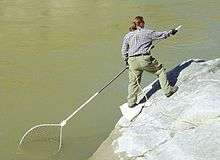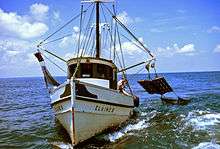Hand net



A hand net, also called a scoop net or dip net, is a net or mesh basket held open by a hoop. It may or may not be on the end of a handle. Hand nets have been used since antiquity and can be used for scooping fish near the surface of the water, such as muskellunge or northern pike.
A hand net with a long handle is often called a dip net. There are popular contemporary dip net Sockeye Salmon fisheries in Chitina, Kenai River, and Kasilof River Alaska, typically lasting two to three weeks, and is regarded as a subsistence fishery for Alaska residents only. Dip nets can also be used to scoop crabs in shallow water. The basket is made of wire or nylon mesh, rather than cloth mesh, since crabs fight, bite, twist and turn when they are caught.[1]
When a hand net is used by an angler to help land a fish it is called a landing net.[2]
Because hand netting is not destructive to fish, hand nets are often used for tag and release, or to capture aquarium fish.
History
Hand nets have been widely used by traditional fishermen. Small fish are caught both in the shallow water of lagoons and in the open sea. They are made in different sizes ranging from small nets held in one hand to large scoop nets worked by several men.[3][4] Historically, the Karuk people of the upper Klamath River harvested fish with dip nets.[5]
In England, hand netting is the only legal way of catching eels and has been practised for thousands of years on the River Parrett and River Severn.[6]
Gallery
 German fisherman with hand lift net, 1568
German fisherman with hand lift net, 1568 A "fisher logo" of Claes Jansz. Visscher, showing a hand net, 1630.
A "fisher logo" of Claes Jansz. Visscher, showing a hand net, 1630. An angler in a float tube with his landing net.
An angler in a float tube with his landing net. George Bush and Vladimir Putin fish from a fish pond, while an aide holds a landing net
George Bush and Vladimir Putin fish from a fish pond, while an aide holds a landing net
See also
Notes
External links
| Wikimedia Commons has media related to Hand nets. |
